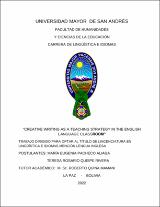Mostrar el registro sencillo del ítem
Creative writing as a teaching strategy in the english language classroom
| dc.contributor.advisor | Quina Mamani, Roberto, tutor | |
| dc.contributor.author | Pacheco Aliaga, María Eugenia | |
| dc.contributor.author | Quispe Rivera, Teresa Rosario | |
| dc.date.accessioned | 2022-08-04T15:21:20Z | |
| dc.date.available | 2022-08-04T15:21:20Z | |
| dc.date.issued | 2022 | |
| dc.identifier.uri | http://repositorio.umsa.bo/xmlui/handle/123456789/29079 | |
| dc.description.abstract | Today’s globalized world poses the need to be able to communicate with a variety of people who do not necessarily speak your language; the rapid progress of science and knowledge involves the production of written material which in most cases uses the English language in order to reach a worldwide audience. These are only two of the many reasons people today, and young people in particular need to achieve a functional command of this language. Many methods have been developed in an effort to make language teaching more effective. In this work the use of Creative Writing is proposed as an approach that could help learners to get the necessary knowledge of the language, because this method promotes the creativity of students which in turn increases their motivation, which is a key factor for successful and continuous learning. For the implementation of this idea, a group of students from the Centro de Acogida Mendez Arcos Center was chosen, among other things because although they could not afford having language classes, they had the right to be trained in this area which is essential for young people today Fortunately after the completion of the project, the results have been very rewarding, most of the students who participated in the training were able to reach a basic level in the use of the English Language mainly in the written form which is where the stress of the method is placed, but additionally they got the vocabulary and grammar knowledge which may enable them to develop further the other skills of the language. In the first chapter, some contextual information about this work is provided. There is a description of the institution, why it was created, what is the regulation framework of its operations, the material and human resources found in the institution as well as other educational assets of its facilities. Then the results of a diagnosis survey conducted among the students is presented, this was the basis to define students’ needs and expectations in relation to learning the English language. The second chapter addresses some relevant theoretical issues, such as the various methods of language teaching that have been used and developed throughout the years; following this there is an introduction of the strategy of Creative Writing as an alternative or relatively new approach to language teaching, describing some of its characteristics that make it a promising and convenient method in order to reach the goals set for this project. The third chapter presents the proposal developed for the project by describing the problem and the general and specific objectives put forward in response to the problem, which in turn outline the syllabus and curriculum design thought to be adequate for this situation. This chapter includes information about the actual implementation of the plan and the role of the Creative Writing approach as a tool to develop and practice vocabulary, sentence construction, and paragraph writing. Finally, the last chapter presents some conclusions and recommendations derived from the design and implementation of this project. | es_ES |
| dc.language.iso | es | es_ES |
| dc.subject | IDIOMA INGLES | es_ES |
| dc.subject | GRAMATICA INGLES | es_ES |
| dc.title | Creative writing as a teaching strategy in the english language classroom | es_ES |
| dc.type | Thesis | es_ES |
| dc.thesisdegreegrantor | Universidad Mayor de San Andrés. Facultad de Humanidades y Ciencias de la Educación. Carrera de Lingüística e Idiomas. | es_ES |
| dc.thesisdegreename | Licenciada en Lingüística e Idiomas | es_ES |

